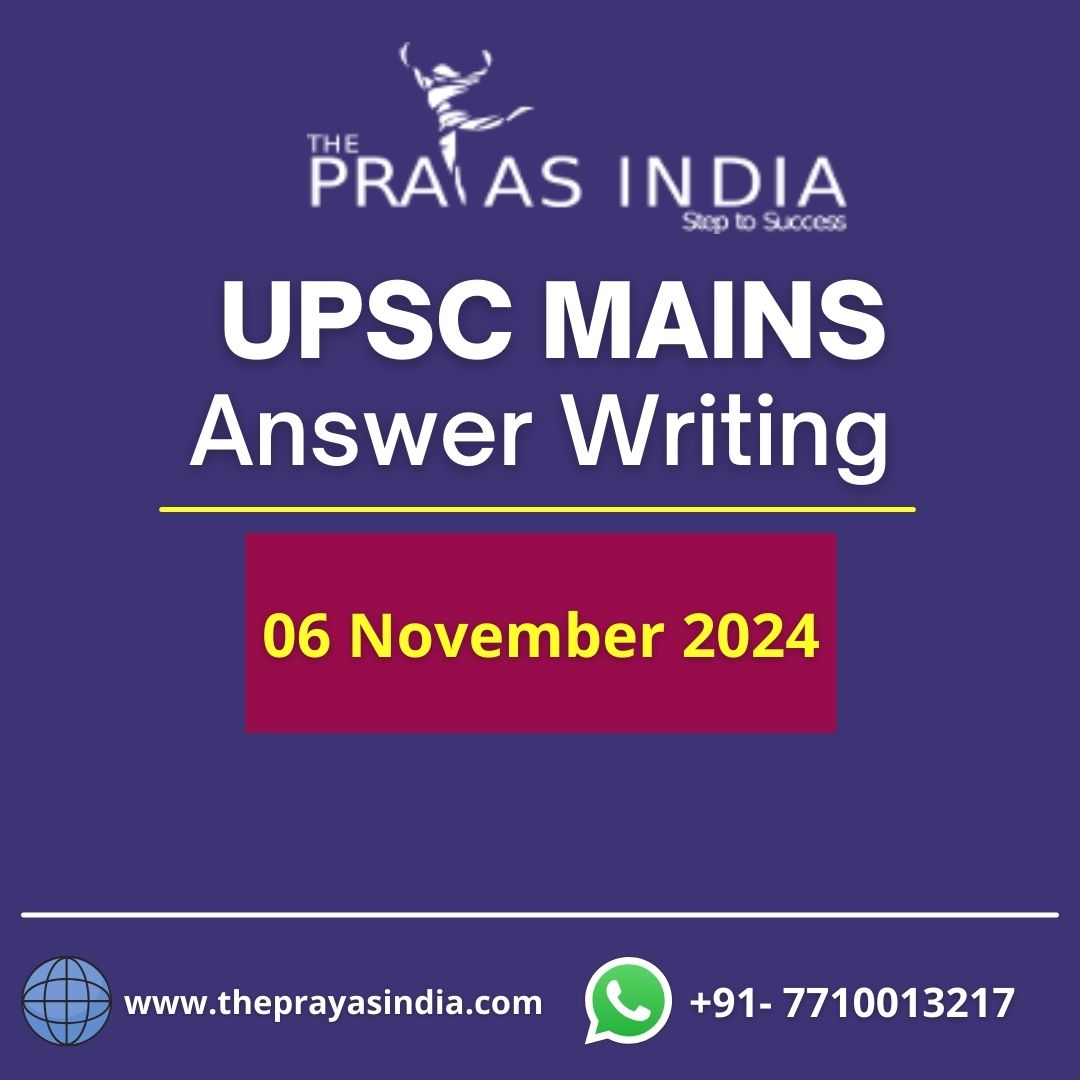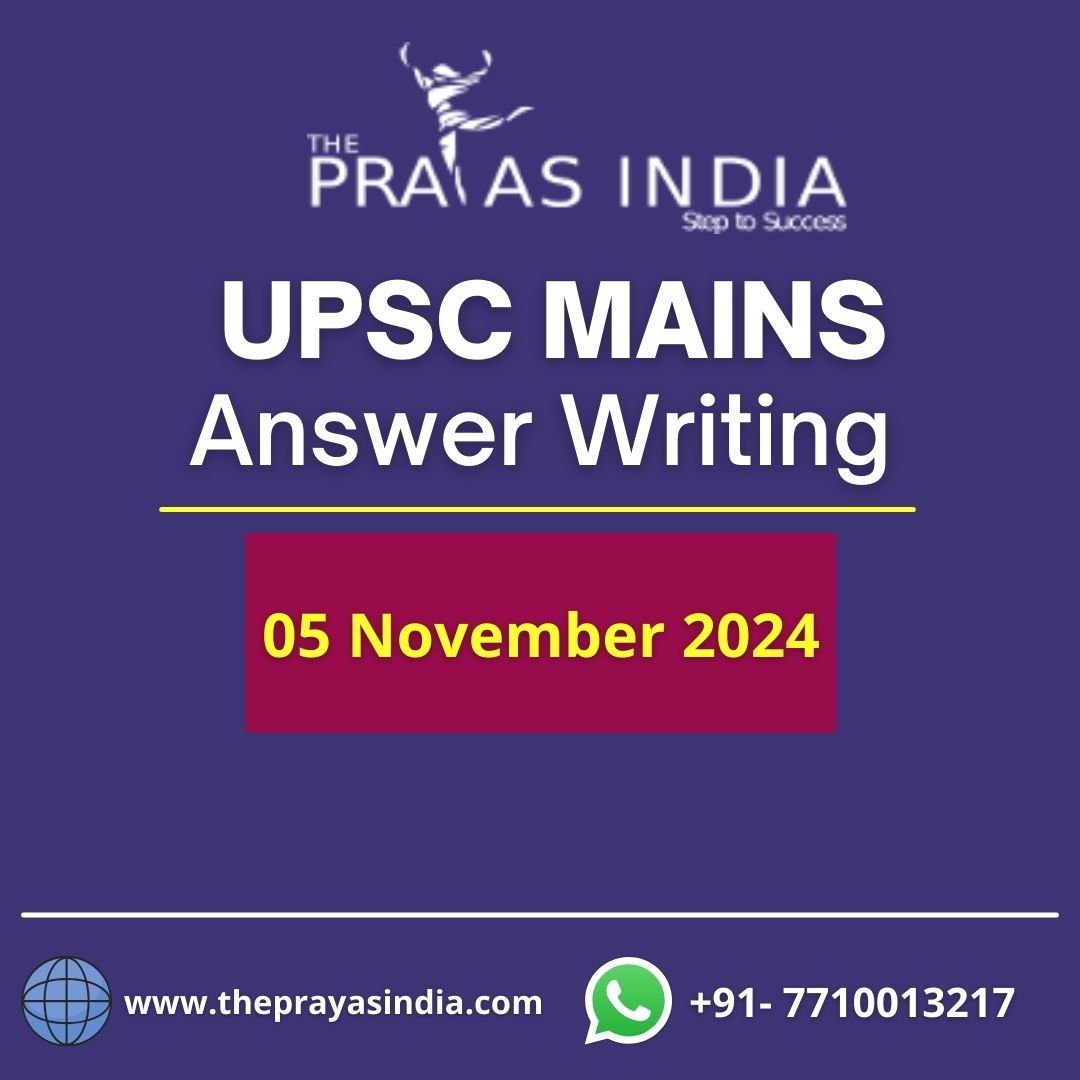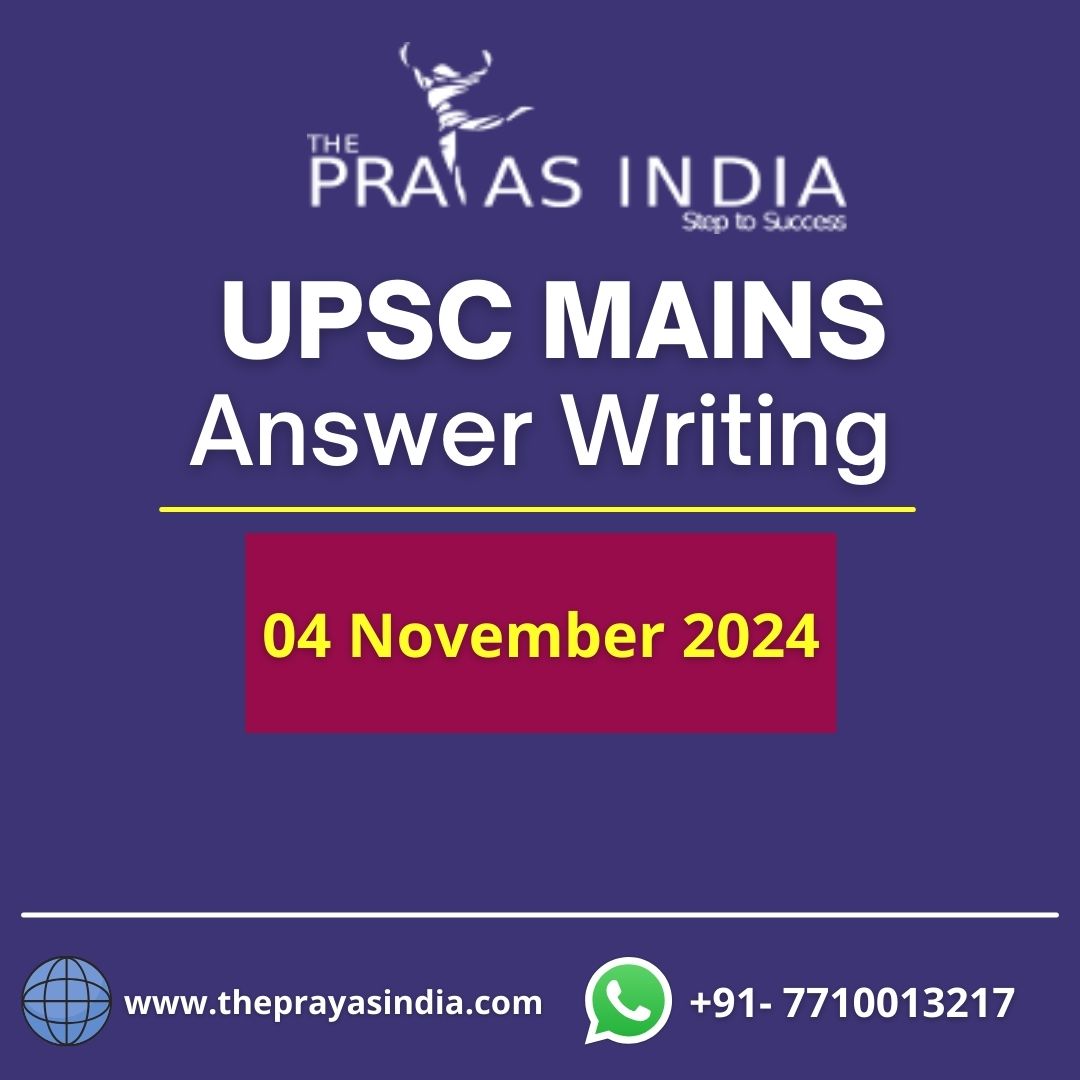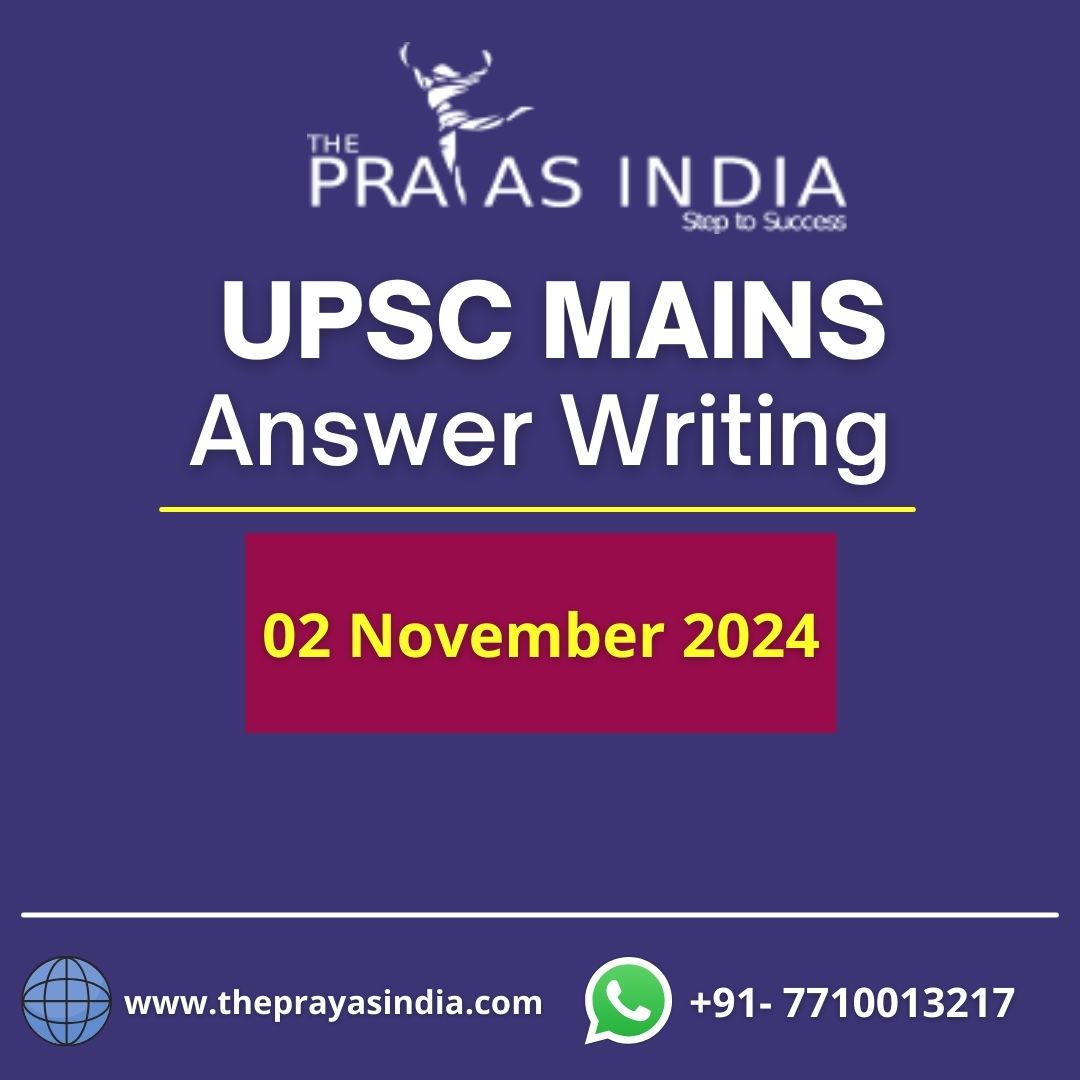MAINS DAILY QUESTIONS & MODEL ANSWERS
Q1. Diverse initiatives have been made to provide people with disabilities (PwD) a life of dignity. However, it is crucial to include people with disabilities as equal partners in their development and decision-making if we are to achieve the aim of inclusivity. Comment. (250 words)
Paper & Topic: GS I – Social issues
Introduction:
- The Rights of Persons with Disabilities Act, 2016, states that a “person with disability” is someone who has a long-term physical, mental, intellectual, or sensory impairment that prevents them from fully and equitably participating in society with others. India is home to 26.8 million persons with disabilities, which is a vast undercount according to the 2011 Census.
- Recently, the Supreme Court issued an interim ruling allowing civil service candidates with physical disabilities who passed the written exam to apply provisionally to the Union Public Service Commission for selection in three categories, including IPS.
Body:
Various initiatives to ensure that people with disabilities (PwD) can live in dignity include:
Provisions of the Constitution:
- According to Article 41 of the Directive Principles of State Policy (DPSP), the State shall, within the bounds of its economic capacity and development, make effective provisions for securing the right to work, to education, and to public assistance in cases of unemployment, old age, sickness, and disability.
- In the state list of the seventh schedule of the constitution, the topic of “relief of the disabled and unemployable” is mentioned.
Governmental Requirements:
The Right of People with Disabilities Act 2016:
- It becomes the responsibility of the Union, the States, and the Union Territories to address the issue.
- Additionally, it is crucial to check that all government buses adhere to the unified standards for accessibility for the disabled.
- The definition of disability is based on a dynamic and developing idea.
- The number of disability categories has grown from 7 to 21. The act added a number of disabilities, such as deaf blindness, acid attack victims, Parkinson’s disease, mental illness, autism, spectrum disorder, cerebral palsy, muscular dystrophy, chronic neurological conditions, speech and language disability, thalassemia, haemophilia, and sickle cell disease, which were largely ignored in the previous act. The Government is also permitted to notify any other category of a particular handicap.
- It raises the percentage of reservations for people with disabilities from 3% to 4% in positions with the government and from 3% to 5% in institutions of higher learning.
- Between the ages of 6 and 18, every kid with a baseline disability is entitled to a free education.
- Both institutions that are recognised by the government and those that are supported by it must offer inclusive education.
- Along with the Accessible India Campaign, emphasis has been placed on ensuring accessibility in public buildings within a specified time range.
- The State Commissioners and the Chief Commissioner for Persons with Disabilities will serve as grievance redressal organisations and regulatory organisations, respectively, overseeing the Act’s execution.
- To give financial assistance to people with disabilities, separate national and state funds were established.
Campaign for an Accessible India: Creating an Environment for People with Disabilities:
- An all-encompassing national movement to achieve universal accessibility will give people with disabilities access to equal opportunities, the freedom to live freely, and the ability to fully engage in all sectors of society.
- The programme aims to improve the built environment’s, transportation system’s, and information and communication ecosystem’s accessibility.
- Deen Dayal Disabled Rehabilitation Scheme: Through this programme, financial support is given to non-profit organisations (NGOs) that provide a range of services to people with disabilities, including special schools, centres for vocational training, community-based rehabilitation, early childhood education, and early intervention.
- Assistance to Disabled Persons for Purchase / Fitting of Aids and Appliances (ADIP): This programme aims to assist disabled individuals by putting appropriate, dependable, cutting-edge, standard aids and appliances within their financial grasp.
Fellowship for Students with Disabilities at the National Level (RGMF):
- The program’s goal is to give individuals with impairments more opportunities to pursue higher education.
- 200 Fellowships are awarded to students with disabilities each year under the Scheme.
- The National Trust’s programmes for the welfare of people with autism, cerebral palsy, mental retardation, and multiple disabilities.
Problems and Obstacles
Health:
- Many disabilities, including those brought on by pregnancy-related illnesses, maternal diseases, malnutrition, as well as accidents and injuries, are avoidable.
- However, the health sector, particularly in rural India, has not taken significant measures to address disability.
- Additionally, there are issues with economical access to quality medical care, assistance, and appliances.
- Another issue is the state of the medical facilities and the poorly qualified medical staff in the rehabilitation institutions.
Education:
- The educational system excludes some students. It continues to be difficult to include kids with mild to moderate disabilities in conventional classrooms.
- There are many problems, including the lack of special schools, barriers to enrollment, qualified teachers, and a lack of accessible educational resources for the disabled.
- Additionally, accommodations for people with disabilities haven’t always been honoured in higher education institutions.
Employment:
- Despite the fact that many disabled persons are capable of performing useful labour, their employment rates are much lower than those of the general population.
- Since there are many fewer disabled workers in the private sector, the situation is significantly worse.
- Physical accessibility in buildings, transportation, and access to services, among other things, continue to be very difficult.
Exclusion from society/discrimination:
- People with disabilities are prevented from participating actively in the family, community, or workforce because of the negative sentiments held by their families and frequently by the disabled themselves.
- Discrimination against people with different abilities occurs frequently. The worst stigma and severe social exclusion are experienced by those with mental disease or mental retardation.
- Lack of reliable and comparable data and statistics: This further prevents the participation of people with impairments. The following are the main challenges with data collection and quantifying disability:
A challenge to define disability:
- Coverage: Different uses call for various disability information
- Disability reporting is resisted because it is stigmatised in many societies and locales.
- The inclusion of disabled people is hampered by inadequate policy and programme execution.
- Although some laws and programmes have been established with the intention of empowering the disabled, their implementation faces numerous difficulties.
Steps to Take:
Prevention:
- All kids need to be screened at an early age, and preventive health programmes need to be expanded.
- Kerala has already launched a campaign for early prevention. The Comprehensive Newborn Screening (CNS) initiative aims to identify baby impairments early and lessen the cost of disability on the state.
Awareness:
- By removing stigma, society can better integrate people with impairments.
- There should be public awareness initiatives to inform people about the various types of disabilities.
- Disability success stories can be shared to encourage people to adopt a positive attitude.
Employment:
- Adults with disabilities must be equipped with marketable skills.
- It is necessary to urge the private sector to hire them.
- Better measurement: By enhancing disability measurement, the scope of impairment in India can be better understood.
Education:
- It is necessary to develop state-level plans for the education of kids with special needs.
- To address the needs of children with disabilities and support their inclusion in conventional classrooms, teachers should have the appropriate training.
- Additionally, there should be more special schools and ensuring that materials are available for students with disabilities.
Access:
- Road safety, residential safety, public transportation, and other safety measures should be implemented.
- Furthermore, it should be made mandatory to make buildings accessible to people with disabilities
Interventions in policy:
- More money should be budgeted for the welfare of the disabled. Disability funding ought to be allocated along with gender funding.
- It is important to verify that plans are implemented correctly. The necessary oversight and accountability of public funds should exist.
Q2. Collegium changes must prioritise increased transparency while removing room for arbitrary decision-making throughout the judicial selection process, all without jeopardising the independence of the judiciary. Elaborate. (250 words)
Paper & Topic: GS I – Judiciary related issues
Introduction:
- In accordance with articles 124(2) and 217 of the constitution, the President of India appoints the judges of the Supreme Court and High Court. The President is required to consult with any Supreme Court and State High Court judges he may determine are necessary for the appointment during this consultation.
Body:
University system:
- Under the Collegium System, the Chief Justice of India and the four senior-most judges of the Supreme Court convene a forum to decide on appointments of judges and lawyers to the Supreme Court as well as transfers of judges to the High Courts and Apex Court.
- The Supreme Court created the collegium of judges. It is not included in the Constitution, which states that the President appoints Supreme Court and High Court judges and mentions a consultation procedure.
- In essence, it is a system in which judges are chosen by a body made up of judges.
- There was a feeling that the independence of the judiciary was under danger after some judges were replaced during the appointment of the Chief Justice of India in the 1970s and attempts made thereafter to affect a mass transfer of High Court justices across the nation. Over the years, this led to a number of cases.
- According to the “First Judges Case” (1981), the “consultation” with the CJI regarding appointments must be thorough and productive.
- The Collegium system was established in 1993 as a result of the Second Judges Case, which ruled that “consultation” actually meant “concurrence”. It was further stated that this was not the CJI’s personal opinion, but rather an institutional opinion developed after consultation with the two senior most Supreme Court judges.
- In the Third Judges Case (1998), the Supreme Court increased the collegium to a five-member panel, consisting of the Chief Justice of India and four of his senior most colleagues, on a Presidential Reference for its judgement.
- If the Collegium recommends judges or solicitors to the government a second time, their recommendations are binding on the central government.
The collegium followed these procedures:
- The CJI and the other SC judges are chosen by the President of India. The outgoing CJI proposes his successor as far as the CJI is concerned.
- The suggestion is started by the CJI for the other judges in the high court. The CJI consults the other collegium members as well as the court’s senior-most judge who is a member of the High Court where the recommended individual is a member.
- According to the policy of having Chief Justices from outside the individual States, the Chief Justice of High Courts is appointed. The collegium makes the decision regarding the promotion. A collegium made up of the CJI and the two most senior judges makes recommendations for High Court judges.
Reforms to the Collegium system are required:
Trustworthiness of the SC:
- The contentious collegium system of judicial selections threatens judges’ independence and casts doubt on the supreme court’s reliability.
- The contemnor’s personality was not evaluated at the time his name was recommended for elevation, which is a failure.
- Example: The collegium of the Chief Justice and the four senior-most judges of the Supreme Court was criticised for passing over ostensibly qualified judges in the debate over the proposed promotion of Justice P.D. Dinakaran of the Karnataka High Court to the Supreme Court.
- The judiciary has recently been involved in a number of these credibility crises.
- As a result, the administration plays little to no part in choosing judges.
Nepotism:
- Unfortunately, it hasn’t always been able to cover itself in glory. In certain instances, high court justices have been appointed without regard for their qualifications to the Supreme Court by their closest relatives.
- justices who were significantly less senior than the combined All India Seniority of High Court justices were appointed to the SC under Chief Justice Ranjan Gogoi’s leadership for the reason that those chosen were deemed to be more deserving.
Supreme Court has too much work to do:
- The Supreme Court was choosing judges for the Supreme Court and High Courts and moving them from one High Court to another without realising the load it was placing on the collegium.
- The judges of the collegium must inevitably be distracted from their primary judicial duties of hearing and deciding cases by an administrative task of this complexity.
Transparency Issues:
- The opaqueness of the collegium system is demonstrated by the absence of a published operating manual, selection criteria, the arbitrary overturning of already made decisions, and the selective disclosure of meeting minutes.
- Nobody is aware of the process used to choose judges, and the appointments made give rise to questions about propriety, self-selection, and nepotism.
- Numerous competent young judges and advocates are frequently disregarded by the system.
NJAC, A Missed Chance:
- The National Judicial Appointments Commission (NJAC) has the power to improve appointment quality, protect the system from unwarranted politicisation, and restore public trust in the system.
- The SC overturned the judgement in 2015 on the grounds that it endangered the independence of the judiciary.
Absence of Agreement Among Members:
- Mutual assent for the appointment of judges is a problem that the collegium members frequently encounter.
- The cracks in the judiciary are exposed by the collegium members’ shadow of distrust.
- For instance, due to a lack of agreement among the collegium members, recently retired CJI Sharad A. Bobde may have been the first chief justice to not make even one recommendation for appointment as a SC judge.
Disparate Representation:
- The higher judiciary’s makeup is the other source of worry. Women are disproportionately underrepresented in the higher judiciary, notwithstanding the lack of caste data.
- Judicial Appointments Delayed:
- As a result of a delay in the collegium’s recommendations for the higher judiciary, the process of appointing judges is delayed.
Reforms to the collegium system are required:
- The current system has to be reviewed in a transparent and inclusive process, ideally by an impartial, broadly based constitutional authority that guarantees judicial supremacy but not judicial exclusivity.
- The members of the collegium must start over and interact with one another.
- A transparent approach increases accountability, which is crucial for breaking the impasse.
- Individual disputes over particular names will persist, but it is important to take precautions to prevent harm to the institutional goal of administering justice.
- The new system must guarantee independence, reflect diversity, exhibit professionalism, and uphold ethical standards.
- The system must set up a body that conducts the selection process independently and impartially.
- National Judicial Appointment Commissions have been established in a number of Commonwealth nations to choose judges.
- These judicial commissions have been effective in the United Kingdom, South Africa, and Canada.
- Another option is to create a constitutional body that will accept the federal concept of diversity and independence in the judiciary for the nomination of judges to the higher courts.
- The period of time in which suggestions must be approved should be set.
- As of right now, the collegium is required to present the President with a panel of potential names for appointments in accordance with preference and other legitimate criteria rather than choosing the necessary number of judges against a certain number of openings.
Brand-new memo of procedure:
- A Memorandum of Procedure was created following the Second and Third Judge Cases to set forth the guidelines for how the Collegium would make recommendations to the Executive.
- Therefore, the government recommended that a new MOP be created and finalised for the selection of SC justices, with the Executive receiving a veto over potential candidates due to national security concerns.
Conclusion:
- The judiciary’s institutional flaws are coming to light as a result of heightened public scrutiny and political pressure. These are not merely the moral shortcomings of one person or the results of a few people’s poor judgement. It serves as yet another example of the institution’s unwillingness to acknowledge its own flaws.




